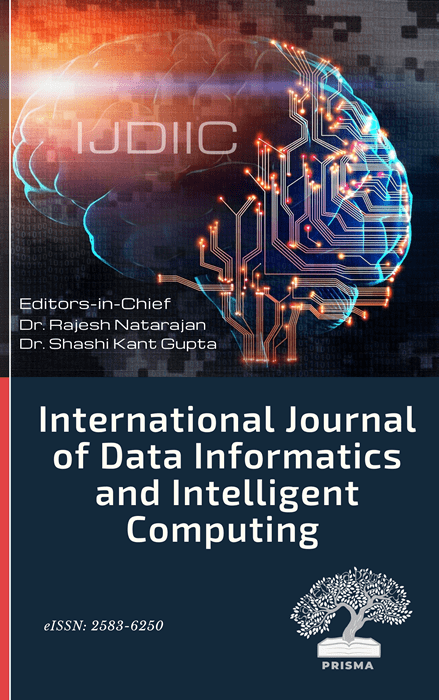Performance Analysis of Voting Regression-Based Ensemble Learning Methods for Food Demand Forecasting
DOI:
https://doi.org/10.59461/ijdiic.v3i2.114Keywords:
Machine learning, Demand forecasting , Regression, Ensemble technique, Voting RegressionAbstract
Accurate demand forecasting has become very significant, especially in the food sector, since many products have a limited lifespan, and improper management can cause the organization to incur enormous waste and loss. This research focuses on the problem of analyzing accurate food demand and its prediction through the application of machine learning techniques. An ensemble technique such as voting regression is employed, leveraging Random Forest Regressor and Gradient Boosting Regressor, which were the top-performing models. By integrating these two techniques using voting regression, we can leverage their complementary strengths to enhance prediction accuracy. The ensemble aggregates the predictions of both models, typically by averaging, to produce a final prediction. This technique can assist in reducing overfitting and capturing complex relationships in the data, resulting in more robust and accurate forecasts of food demand. The outcomes of the R2-score, Root Mean Square Error (RMSE) and Mean Average Error (MAE) are 0.99, 0.01, and 0.00, respectively.
Downloads
References
S. K. Panda and S. N. Mohanty, “Time Series Forecasting and Modeling of Food Demand Supply Chain Based on Regressors Analysis,” IEEE Access, vol. 11, pp. 42679–42700, 2023, doi: 10.1109/ACCESS.2023.3266275.
V. Kumar and V. V. K. Kumar, “Food Demand Prediction using Deep Learning,” IRE Journals, vol. 6, no. 10, pp. 1–5, 2023.
M. Aci and D. Yergök, “Demand Forecasting for Food Production Using Machine Learning Algorithms: A Case Study of University Refectory,” Teh. Vjesn., vol. 30, no. 6, pp. 1683–1691, Dec. 2023, doi: 10.17559/TV-20230117000232.
H. . P. and K. . S. Kruthika V, Lavanya H.R, Mahalakshmi E.H, Ranju P.S.R, “Integrated Approach for Food Donation System, Restaurant Food Demanding forecasting using Machine Learning, and Global Food Waste Analysis,” Int. Res. J. Mod. Eng. Technol. Sci., Jul. 2023, doi: 10.56726/irjmets42802.
H. M. Merdas and A. H. Mousa, “Food sales prediction model using machine learning techniques,” Int. J. Electr. Comput. Eng., vol. 13, no. 6, p. 6578, Dec. 2023, doi: 10.11591/ijece.v13i6.pp6578-6585.
A. Keprate and R. M. C. Ratnayake, “Using gradient boosting regressor to predict stress intensity factor of a crack propagating in small bore piping,” in 2017 IEEE International Conference on Industrial Engineering and Engineering Management (IEEM), IEEE, Dec. 2017, pp. 1331–1336. doi: 10.1109/IEEM.2017.8290109.
T. Tanizaki, T. Hoshino, T. Shimmura, and T. Takenaka, “Restaurants store management based on demand forecasting,” Procedia CIRP, vol. 88, pp. 580–583, 2020, doi: 10.1016/j.procir.2020.05.101.
U. Singh, M. Rizwan, M. Alaraj, and I. Alsaidan, “A Machine Learning-Based Gradient Boosting Regression Approach for Wind Power Production Forecasting: A Step towards Smart Grid Environments,” Energies, vol. 14, no. 16, p. 5196, Aug. 2021, doi: 10.3390/en14165196.
B. Erdebilli and B. Devrim-İçtenbaş, “Ensemble Voting Regression Based on Machine Learning for Predicting Medical Waste: A Case from Turkey,” Mathematics, vol. 10, no. 14, p. 2466, Jul. 2022, doi: 10.3390/math10142466.
A. Arjomandi-Nezhad, A. Ahmadi, S. Taheri, M. Fotuhi-Firuzabad, M. Moeini-Aghtaie, and M. Lehtonen, “Pandemic-Aware Day-Ahead Demand Forecasting Using Ensemble Learning,” IEEE Access, vol. 10, pp. 7098–7106, 2022, doi: 10.1109/ACCESS.2022.3142351.
K. Posch, C. Truden, P. Hungerländer, and J. Pilz, “A Bayesian approach for predicting food and beverage sales in staff canteens and restaurants,” Int. J. Forecast., vol. 38, no. 1, pp. 321–338, Jan. 2022, doi: 10.1016/j.ijforecast.2021.06.001.
A. Keprate and R. M. Chandima Ratnayake, “Remaining Fatigue Life Prediction of Topside Piping Using Response Surface Models,” in 2018 IEEE International Conference on Industrial Engineering and Engineering Management (IEEM), IEEE, Dec. 2018, pp. 237–241. doi: 10.1109/IEEM.2018.8607831.
Downloads
Published
How to Cite
Issue
Section
License
Copyright (c) 2024 Denis R, Keerthana D

This work is licensed under a Creative Commons Attribution-ShareAlike 4.0 International License.








